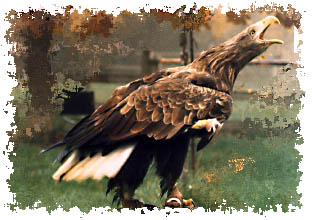Eagles are large day-flying birds of prey, which along with hawks, harriers and old-world vultures comprise the family Accipitridae. Eagles belong to the subfamily Buteoninae, typified by the European buzzards and large American hawks (Buteo); they are distinguished from others of the subfamily by their large, strongly hooked beak, great talons and keen vision. They range throughout the world, and are famous for their powerful, stately flight.
The sea eagles (Haliaeetus) range across all continents except South America, and may be distinguished from typical eagles by the naked lower leg. They generally eat fish and are largely robbers and scavengers. Of the eight species, the noble-looking bald eagle (H. Leucocephalus) is confined to North America.
The White-tailed Eagle or Sea Eagle, Haliaeetus albicilla, like the others of this genus, has bare unfeathered legs. It is the largest of the European eagles, the female measuring up to 3 feet in length and over 8 feet across the wings. The plumage is brown, the head a somewhat lighter shade, the wedge-shaped tail white in adult birds. It breeds in eastern and northern Europe, also in Siberia. Clearly visible in flight is the bird's characteristic wedge-shaped tail.